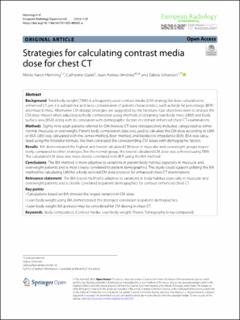| dc.contributor.author | Johansen, Safora | |
| dc.contributor.author | Henning, Mette Karen | |
| dc.contributor.author | Gunn, Catherine | |
| dc.contributor.author | Arenas-Jiménez, Juan | |
| dc.date.accessioned | 2023-07-06T11:00:00Z | |
| dc.date.available | 2023-07-06T11:00:00Z | |
| dc.date.created | 2023-06-23T14:34:04Z | |
| dc.date.issued | 2023 | |
| dc.identifier.uri | https://hdl.handle.net/11250/3076551 | |
| dc.description.abstract | Background
Total body weight (TBW) is a frequently used contrast media (CM) strategy for dose calculation in enhanced CT, yet it is suboptimal as it lacks consideration of patient characteristics, such as body fat percentage (BFP) and muscle mass. Alternative CM dosage strategies are suggested by the literature. Our objectives were to analyze the CM dose impact when adjusting to body composition using methods of obtaining lean body mass (LBM) and body surface area (BSA) along with its correlation with demographic factors in contrast enhanced chest CT examinations.
Methods
Eighty-nine adult patients referred for CM thoracic CT were retrospectively included, categorized as either normal, muscular, or overweight. Patient body composition data was used to calculate the CM dose according to LBM or BSA. LBM was calculated with the James method, Boer method, and bioelectric impedance (BIA). BSA was calculated using the Mostellar formula. We then correlated the corresponding CM doses with demographic factors.
Results
BIA demonstrated the highest and lowest calculated CM dose in muscular and overweight groups respectively, compared to other strategies. For the normal group, the lowest calculated CM dose was achieved using TBW. The calculated CM dose was more closely correlated with BFP using the BIA method.
Conclusions
The BIA method is more adaptive to variations in patient body habitus especially in muscular and overweight patients and is most closely correlated to patient demographics. This study could support utilizing the BIA method for calculating LBM for a body-tailored CM dose protocol for enhanced chest CT examinations.
Relevance statement
The BIA-based method is adaptive to variations in body habitus especially in muscular and overweight patients and is closely correlated to patient demographics for contrast-enhanced chest CT.
Key points
• Calculations based on BIA showed the largest variation in CM dose.
• Lean body weight using BIA demonstrated the strongest correlation to patient demographics.
• Lean body weight BIA protocol may be considered for CM dosing in chest CT. | en_US |
| dc.language.iso | eng | en_US |
| dc.rights | Navngivelse 4.0 Internasjonal | * |
| dc.rights.uri | http://creativecommons.org/licenses/by/4.0/deed.no | * |
| dc.title | Strategies for calculating contrast media dose for chest CT | en_US |
| dc.type | Journal article | en_US |
| dc.type | Peer reviewed | en_US |
| dc.description.version | publishedVersion | en_US |
| cristin.ispublished | true | |
| cristin.fulltext | original | |
| cristin.qualitycode | 1 | |
| dc.identifier.doi | https://doi.org/10.1186/s41747-023-00345-w | |
| dc.identifier.cristin | 2157526 | |
| dc.source.journal | European Radiology Experimental | en_US |

